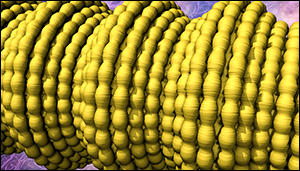Scientists Stretch Electrically Conducting Fibers to New Lengths
27. 7. 2015 | UT Dallas | www.utdallas.edu
An international research team based at The University of Texas at Dallas has made electrically conducting fibers that can be reversibly stretched to over 14 times their initial length and whose electrical conductivity increases 200-fold when stretched.
The research team is using the new fibers to make artificial muscles, as well as capacitors whose energy storage capacity increases about tenfold when the fibers are stretched. Fibers and cables derived from the invention might one day be used as interconnects for super-elastic electronic circuits; robots and exoskeletons having great reach; morphing aircraft; giant-range strain sensors; failure-free pacemaker leads; and super-stretchy charger cords for electronic devices.

In a study published in the issue of Science, the scientists describe how they constructed the fibers by wrapping lighter-than-air, electrically conductive sheets of tiny carbon nanotubes to form a jelly-roll-like sheath around a long rubber core. The new fibers differ from conventional materials in several ways. For example, when conventional fibers are stretched, the resulting increase in length and decrease in cross-sectional area restricts the flow of electrons through the material. But even a “giant” stretch of the new conducting sheath-core fibers causes little change in their electrical resistance, said Dr. Ray Baughman, senior author of the paper and director of the Alan G. MacDiarmid NanoTech Institute at UT Dallas.
One key to the performance of the new conducting elastic fibers is the introduction of buckling into the carbon nanotube sheets. Because the rubber core is stretched along its length as the sheets are being wrapped around it, when the wrapped rubber relaxes, the carbon nanofibers form a complex buckled structure, which allows for repeated stretching of the fiber.
Read more at UT Dallas
Image Credit: UT Dallas
-jk-




